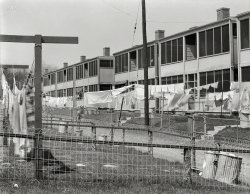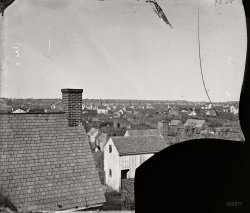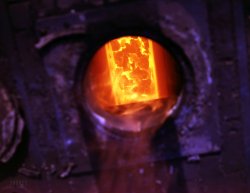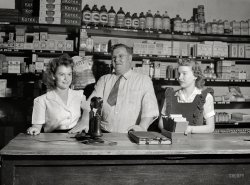
MAY CONTAIN NUTS

Search Shorpy
SHORPY ART

Framed or unframed, desk size to sofa size, printed by us in Arizona and Alabama since 2007. Explore now.
Join and Share
Ad-Free Shorpy
Shorpy is funded by you. Patreon contributors get an ad-free experience.
Learn more.

Recent comments
- Alas, hidden from view
- Exclusive pump
- Details, Details
- What's that building to the left of the tower?
- Coal Barges
- Bromo-Seltzer
- Inner harbor
- The Basin
- What a headache!
- Giant stepladder?
- Baldwin 62303
- Baldwin VO-1000
- Cold
- No expense spared
- Tough Guys
- Lost in Toyland
- And without gloves
- If I were a blindfolded time traveler
- Smoke Consumer Also Cooks
- Oh that stove!
- Possibly still there?
- What?!?
- $100 Reward
- Freeze Frame
- Texas Flyer wanted
- Just a Year Too Soon
- WWII -- Replacing men with women at the railroad crossing.
- Yes, Icing
- You kids drive me nuts!
- NOT An Easy Job
Member Photos
The Shorpy
Print Emporium
Print Emporium
Search Shorpy
Search results -- 30 results per page
- The Clothesline Kid: 1939
- ... houses; a close look at the upper floor shows some clothes lines inside these porches with laundry on them.
Anyone want to play? Besides what he's got tucked under ... Posted by Dave - 04/23/2013 - 10:18am -

- Slabtown: 1864
- ... into the past. It must have been a windy day as the laundry on lines is moving, but not the pair of long johns on the fence. What do you ... Posted by Dave - 03/25/2009 - 10:26pm -

- The Unnamed Soldier: 1864
- ... grapevines or wisteria. It seems a bit much for hanging laundry to dry.
Its purpose is probably obvious to former boy scouts, but ... what their camps looked like anywhere near the front lines, though. Still, it is nice to know that they were at least comfortable ... Posted by Dave - 07/12/2014 - 2:41pm -
![The Unnamed Soldier: 1864 August 1864. "Petersburg, Virginia. Federal soldier's quarters." A glimpse of camp life. Wet plate glass negative by Timothy H. O'Sullivan. View full size.
TaggedThis man appears to be wearing a dog tag, a new thing at that time. The Army did not issue dog tags until 1913, but soldiers could and did purchase them from private suppliers.
The camp furniture reminds me of the things we used to build as Boy Scouts. By then, you couldn't cut down trees for the purpose, so we would practice building them, re-using the same old poles. We never actually took the stuff camping.
Nice Bed!Made a bed just like that long time ago in Boy Scouts! I remember it wasn't too bad to sleep in once you stuffed enough pine needles into it. Nice looking camp given the time and place.
Great Looking CampsiteHe would have won the million dollars on "Survivor" with no problem.
I don't get itCan someone explain the purpose of the superstructure? He's not going to be there long enough to train grapevines or wisteria. It seems a bit much for hanging laundry to dry.
Its purpose is probably obvious to former boy scouts, but not to me.
[The shady shelter is called a brush arbor. - Dave]
Looks pretty comfy!That is, as long as the weather was nice. This obviously wasn't what their camps looked like anywhere near the front lines, though. Still, it is nice to know that they were at least comfortable part of the time.
War coverageThe siege of Petersburg ran from June of ’64 to March of ’65. Plenty of time to continue to build, add to, and modify a soldier’s bivouac. I wonder if at some point that “superstructure” was covered with tarps to provide a larger sheltered area, especially in the winter. Later the tarps came down and the pup tents came up? Just a theory.
HeadquartersArbors of all sorts were used for protection from the sun in the camps of both sides--particularly in headquarters areas. The soldier were issued shelter tent halves and if the found materials for shebangs used the tents for a roof. This looks like some sort of headquarters. The infantry camps would be less permanent looking due to constant shifting of positions.
Soldier did purchase ID disks--about the size of a half dollar. The light spot on the placket of his shirt may just be that. The ID disk would likely be under his shirt. I see a big button on his coat.
To the far left of the soldier is the framework for another shelter with the canvas off. A half-wall has been fashioned out of a hardtack box and you can see the bed frame with a blanket.
The cast iron tea pot and sheet tin frying pan are now very collectible. I see two cloth-covered canteen on the tree, but I do not know what the object hanging on the tent ridge pole is. A sponge or another canteen?
Shady charactersAn almost identical illustration is included in a classic Civil War book on soldiering, "Hardtack & Coffee" by John D. Billings, published in 1887. He even mentions that in the summer the tents would be raised (like this one) to provide headroom and space for cots, and allowing air to circulate.
(The Gallery, Camping, Civil War, Timothy O'Sullivan)](https://www.shorpy.com/files/images/01305a.thumbnail.jpg)
- King Street: 1921
- ... direction." - Dave]
King Street Where the power lines seem to end, King Street takes a sharp downhill for 3 or 4 blocks, and ... twin building on the opposite corner. near the Charlie Lee laundry. Any pics of that corner?
Clang Clang Clang A single trolley ... Posted by Dave - 04/06/2013 - 11:47am -
![King Street: 1921 King Street in Alexandria, Virginia. 1921 or 1922. View full size. National Photo Company Collection glass negative. Who can pinpoint the intersection?
King and WashingtonThat's the intersection of King and Washington streets. The surplus store is now Cafe Mezzogirono.
Overhead WiresThere seems to be 2 overhead wires for 1 set of street car tracks. This seems quite unusual as street cars only required 1 overhead wire. Is it possible that 2 different transportation companies shared a set of tracks but drew power from their individual overhead wires?
[It's a dual-wire trolley. Not unusual. From another commenter: "To avoid use of frogs where the line diverged or at a siding so trolleys could pass each other, dual wires were used, one for each direction." - Dave]
King StreetWhere the power lines seem to end, King Street takes a sharp downhill for 3 or 4 blocks, and then there's the Potomac. The trees in the distance are on the other side of the river, in Maryland.
BumblefishCurrent view of the cafe from Google:
http://www.panoramio.com/photo/2854664
Other cornerLooks nearly like a twin building on the opposite corner. near the Charlie Lee laundry. Any pics of that corner?
Clang Clang ClangA single trolley pole collects current from an overhead wire and uses the tracks as the electrical return. Trolley buses, which have no ground because of their rubber tires, have to use two trolley poles and dual overhead wires. One for the negative live current and the other for the positive or neutral return. Which might have been the case here.
The treesAmazing how there are no trees in the first picture, but how tall they are in the modern picture. The tellaphone pole is gone and so are the trolley tracks.
Sweet RideThat's a swell motorcycle! Not your run-of-the-mill Harley or Indian, it appears to be a Douglas, or maybe even a Scott, an early water-cooled bike.
Harley Model 20Great bike! It's got the longitudinally oriented opposed twin engine, but it's not a Douglas, it's a Harley Davidson Sport Model 20, which was produced from 1919 to 1923.
Cheers!
Craig
LOC Number Please...I've done a quick search for this shot on the Library of Congress site but can't seem to find it. Does anyone have the reference number?
[Right-click on the photo, choose "properties." There's the number. - Dave]
+89Below is the same view from December of 2010.
(The Gallery, Cars, Trucks, Buses, Motorcycles, Natl Photo)](https://www.shorpy.com/files/images/30009u.thumbnail.jpg)
- Hell Gate: 1942
- ... through West Virginia at night in the 1950s and seeing lines of glowing coke ovens. It seemed to me like a way of separating the smoke ... Daytime revealed a moonscape of grey... Grey houses, grey laundry on lines, grey lawns, grey rocks, grey slag. The astronauts practised ... Posted by Dave - 08/30/2012 - 4:46pm -

- Ott's Esso Arboretum: 1937
- ... maybe around P or Q Streets.
So much to see Laundry out on several clothes lines drying. A couple of great looking convertibles, especially the car on the ... Posted by Dave - 02/27/2013 - 8:30am -
![Ott's Esso Arboretum: 1937 July 1937. "Gas station in Washington, D.C." Ott's Esso Service, providing our second example in as many weeks of gas-station faux flora. Maybe this was a thing back then. Medium format negative by John Vachon. View full size.
Feat of clayLove the fancy brickwork in the road.
TriangulationCan anyone roughly pinpoint the location of this gas station based on the distances to the cities on the chart?
["Roughly pinpoint" -- phrase of the day! - Dave]
One-Stop ServiceOtt's Service Station was located at 12th and H Streets N.W. but branch locations included 923 H St. N.W., 7th and Rhode Island Ave. N.W, and Sherman Ave. and Park Rd. N.W. The corner at 12th and H has been entirely rebuilt since 1937 which challenges the ability to definitively connect this photo with that location.
[As indicated by the sign on the mural, the name of the business was Ott's Service Stations, plural, with every station being a "branch." - Dave]
I am in total agreement with stevendm on the impressive craftsmanship of the paved street stonework.
Hopefully some DC historical trolley buff might be able to collaborate one of the above locations of Ott's Service Stations with the location of tracks along a route of the 1930s streetcar system.
Gas artReminiscent of gas station road maps of the period, like this one that's been in our family since the year one, as my mother would say.
Doing it rightThere's so much to love in this shot: the two attendants (the guy with no coin changer is probably in training) in the middle of the photo just waiting for their next customer, the (rare) convenient soda bottle machine (certainly 5 cents per 6-oz. bottle) next to the pumps, and the helpful "distance to" signs on the back wall.
And what IS that four-story building where the mural is painted? The gas station office is apparently on the right side, where all the action is.
Wonderful slice of life from an era where a fill-up probably cost 85 cents.
[The other "attendant" is wearing mechanic's coveralls. - Dave]
Coin changerA classic from the days when every transit operator carried and received and processed cash. The metallic sound of it was hypnotic, more so in the hands of a skillful and experienced change-maker. I had one of my own at home and would gladly make change for anyone who asked. Still made by a company named McGill, in Illinois.
LocationThis looks like it might be on Wisconsin Avenue in Georgetown, maybe around P or Q Streets.
So much to seeLaundry out on several clothes lines drying. A couple of great looking convertibles, especially the car on the left side street. The rumble seat open on the other, and it with no windshield! The the fellow looking under the coupe on the far right. And finally the person on the 3rd floor shaking out their throw rug from the window. All at 4:45 PM on another typical summer day!
Re: TriangulationBased on the mountain at the back of the picture (which by the way looks strangely like the Paramount Pictures logo), I'd guess we could "roughly pinpoint" the location to exactly somewhere on Planet Earth; more or less.
It's at the corner of what and what?I knew this photo looked familiar. That nifty book of vanished DC, "On This Spot," lists this station as being located at 36th and M Streets NW, over in Georgetown. (Page 194 for those of us that want to check). Given the incline of the street seen at the left side of the photo, and streetcar tracks embedded in the street in the foreground, this seems a likely location.
[There were numerous Ott Esso stations in the District. - Dave]
Not streetcars or trolleysThe fact that there are 3 'rails' reveals that this is a cable car system of the type that still runs in San Francisco.
[Most of the system was electrically powered. Streetcars got their juice through a "foot" that ran in the center groove. - Dave]
30th & M Street?Based on this image from the DDOT library it could be the corner of 30th and M Streets.
(The Gallery, D.C., Gas Stations, John Vachon)](https://www.shorpy.com/files/images/SHORPY_8b29417a.thumbnail.jpg)
- Washington, D.C.: 1935
- ... not in this time period, hence all the clothes on clothes lines. It looks like wash basins were used for seating on the back porches.
... window into my alley in D.C. is very similar. Not so much laundry, but rugs and towels hang from porches. It's cleaner, most of the ... Posted by Dave - 02/07/2013 - 9:09pm -
![Washington, D.C.: 1935 Washington tenements, Nov. 1935. View full size. Photo by Carl Mydans.
Great PhotoMy father would have been 10 years old in 1935. Looking carefully at the detail of this photo, one wonders if they had plumbing for bathrooms. It's obvious clothes dryers were not in this time period, hence all the clothes on clothes lines. It looks like wash basins were used for seating on the back porches.
The problem with B&W photos, although it is nostalgic and it forces you to really look for detail, it makes most photos look "dirty" because you can't see any color. It also gives it a sad ambience. Most people in these older B&W photos are not smiling. Maybe it was the depression era. If these photos were in color, it would be a whole completely different feel. When I think of the early years, I NEVER think of them in my mind in color. Always B&W. I wish I knew how to colorize some of these....just for a different feel.
[Here's a color photo from the same city, seven years later (1942). - Dave]
Sleeping PorchesThe back alleys of DC looked radically different 40-90 years ago, in part because "sleeping porches" were common. In the absence of air-conditioning families would typically sleep on these porches in high summer. Rickety porches like these were torn down, better built ones were incorporated into the house with walls in the 60s-70s and are a noticeable feature in Georgetown if you know what to look for.
TenementsIts amazing how this could be passed off as a modern apartment complex, only the cars and the dress style gives away the time period.
Everything but the clotheslinesThe view out the window into my alley in D.C. is very similar. Not so much laundry, but rugs and towels hang from porches. It's cleaner, most of the rubbish is in cans. Instead of washtubs and baskets the porches and alley are cluttered with storage bins, grills, coolers, etc. Yes, my alley looks very similar.
(The Gallery, Carl Mydans, D.C., Great Depression)](https://www.shorpy.com/files/images/8b26508uu.thumbnail.jpg)
- Family Business: 1943
- ... Team Crazy, the number of uses for borax: alone as a laundry detergent booster; mixed with ammonium chloride to produce a flux when ... the Mule Team model as well. Went together well, but the lines for the mules and painting it were my troubles. I guess at 7 my sense of ... Posted by Dave - 10/14/2015 - 11:36am -
























